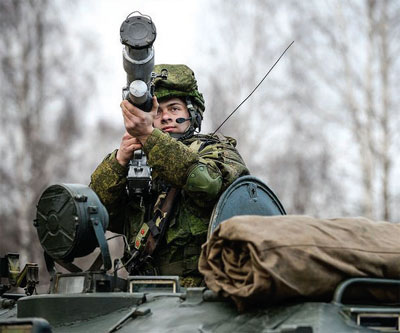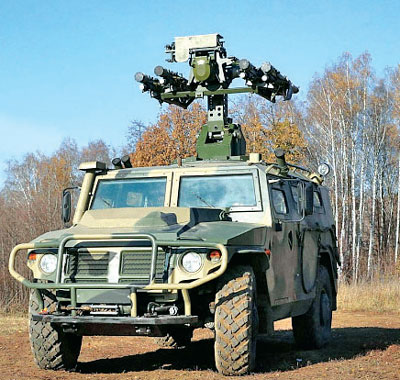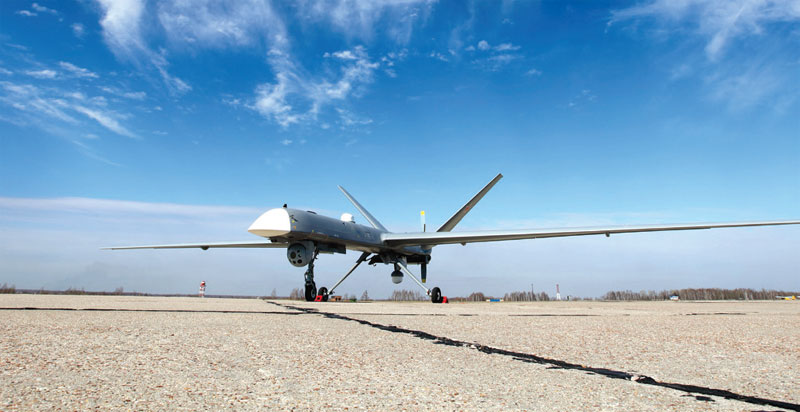How the radio-electronic dome is disabling the unmanned aerial systems

On April 15, the Russian ministry of defence (MoD) published a detailed report on the radio-electronic counter-unmanned aerial vehicle (C-UAV) warfare in Syria. According to the MoD, the activity of UAVs used by terrorists for reconnaissance and attacks on the Russian naval and air bases in Syria has decreased due to the effective use of electronic warfare (EW) systems.
The military demonstrated to the media the intercepted drones, including two serial quadcopters and an improvised UAV with a warhead. Their control and radio navigation channels had been jammed, resulting in a forced landing. According to the commander of the EW component at the Tartus naval base Denis Kulikov, a kind of C-UAV dome has been established in Syria.
“The Pole-21 jamming station and the Ratnik-Kupol system, which is designed to suppress UAV control channels, are used. The airspace here is also covered with the latest Russian EW systems capable of blinding the pilots of enemy aircraft. Targets are detected by the Krasukha S-4 system, while the shipborne TK-25 complex suppresses their integral radars,” said Kulikov.
Pole-21–The jammer
The Pole-21 EW system, designed by the NTC REB enterprise, has already been mentioned in the MoD’s news regarding its introduction into the Russian Armed Forces and its frequent use during the field exercises.
The system is designed to protect strategically important objects from cruise missiles, UAVs and guided aerial bombs through radio suppression of equipment binding them to global satellite and radio navigation systems.
According to the Russian MoD, Pole-21 allows an operator to establish up to 100 radio jamming posts in the covered zone, and is well adapted to different climatic conditions, being capable of functioning in a temperature range between -40 degree С and +50 degree C. The system can suppress GPS, Galileo, and BeiDou satellite navigation systems.

The Newest Russian C-UAV Network
At both biggest international defence shows that have taken place till date in 2021–Aero India 2021 in Bengaluru, India and at IDEX 2021 in Abu Dhabi, the United Arab Emirates–Russia showcased its integrated solution to thwart the UAV threat–a modular scalable package that combines soft-kill and hard-kill systems (i.e., radio-electronic warfare and missile systems, as well as radars).
As the speaker at the official presentation pointed out, the UAV jamming systems are of the utmost effectiveness against light and medium drones, while short-range air defense systems are better suited to intercept the larger drones.
The Repellent-Patrol EW system developed and manufactured by the Defense Systems company provides area coverage. The Repellent-Patrol is a long-range system capable of jamming drones at a range of up to 20km. The Kupol and Rubezh-Avtomatika systems developed by Rostec’s Avtomatika Concern carry out continuous radio surveillance and create a protective dome over the installation within a radius of at least 3km. The Avtomatika’s Pishchal EW gun is one of the lightest man-portable jammers on the market, weighing a mere about 3.5 kg. It can jam UAV control/navigation channels at a range of 2 km.
As a hard-kill component of the integrated counter-UAV system, the well-known KBP’s Pantsir-S1 self-propelled anti-aircraft gun/missile system or Almaz-Antey’s Tor-family SAM system are offered.
MANPADS Component
The close-in air defense is provided by the Igla-S MANPADS, as well as the Gibka-S VSHORAD combat vehicles capable of firing Igla-S missiles. These systems can destroy targets at a maximum range of 6 km and at a maximum altitude of 3.5 km.

The Igla-S MANPADS developed by the Machine-Building Design Bureau company (a subsidiary of Rostec’s holding High-Precision Weapons) is developed on the basis of the Igla system. Its major features include an increased weight of explosive warhead (1.5-fold, compared to the Igla missile), introduction of a proximity fuze in addition to the existing impact fuse, improved missile accuracy, night-fire capability with a night sight, and a firing range increased from 5.2km to 6.0km. The Igla-S is said to be specifically suited to hit small-size targets, including cruise missiles and unmanned aerial vehicles.
In August 2020, Dmitry Shugaev, Director of Russia’s Federal Service for Military-Technical Cooperation (FSMTC) in his interview with the Zvezda TV channel mentioned the market outlook of the Igla-S system in India.
“I hope that in the near future an agreement will be signed on the production and supply of Igla-S in the interests of India, considering the fact that we won the competition unconditionally”, said Mr. Shugaev.
The Gibka-S mobile air defense missile system is based on the TIGR wheeled armoured vehicle. It employs 4 Igla-S missiles on the launcher and 4 missiles in stowage. The missiles can be fired in on-the-move. The system can provide protection of various facilities against cruise missiles and UAVs flying at low and extremely low altitudes.

Russia Enters the UCAV League
If we take a look at the other side of the coin, Russia has also finally entered the league of nations that have developed and offered to the global market the combat unmanned aerial vehicles (UCAV). At IDEX 2021 in Abu Dhabi it officially showcased at the national exposition the model of the Orion-E medium-altitude long endurance (MALE) UAV equipped with the aerial munitions. This is the first official presentation by Russia of the armed Orion-E at the foreign expo and seems to be the first ever public demonstration of the Russian attack drone abroad.

According to the developer, the private Kronshtadt Group, the drone can use a broad range of munitions.
At the ARMY 2020 expo near Moscow in 2020 Kronstadt showcased the attack version of the Orion, but with munitions presented separately in front of it.
Orion is a long-endurance unmanned aerial vehicle intended for performing missions in a wide range of climate zones. It has a long flight duration and is able to conduct reconnaissance in the optical, infrared and radio wave ranges. The maximum take-off weight is one ton, the maximum payload weight is 200 kg. The range of use is 300 km.

